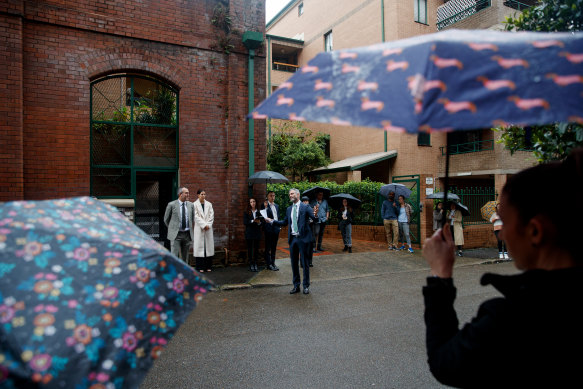The Sydney suburbs where home owners can’t afford their mortgages
As many as one in 30 households have fallen behind on their mortgage repayments in a string of western Sydney suburbs and the Illawarra.
Some 3.53 per cent of home loans in Abbotsbury in Sydney’s south-west are at least 30 days in arrears, Moody’s Ratings warns, as owners are hard hit by higher interest rates and the rising cost of living.
The figure sits at 3.16 per cent in Fairfield, while Bligh Park in the north-west is also at 3.16 per cent.
At least 2.7 per cent of loans are in arrears in Punchbowl, Bankstown and Airds, as well as Albion Park and Avondale in the Illawarra. Chifley was the only pocket of the eastern suburbs in the top 10.
Sydney’s outer south-west, south-west and inner south-west overall had higher delinquency rates as of November 2023 than more affluent regions such as the northern beaches and North Sydney, the Moody’s report found.
The share of households falling behind on their mortgages is rising around the country and tipped to increase this year as households buckle under pressure, but the impact is uneven.
Borrowers in outer suburbs tend to have relatively lower incomes and less disposable incomes than in inner suburbs, Moody’s Ratings vice president and senior credit officer Alena Chen said.
Outer suburbs have less diverse job markets, and if a region has many workers in risky industries such as construction, there can be concentrated job losses that affect borrowers from being able to meet their repayments, she said.
“That same magnitude of increase in interest rates would be a bigger burden on borrowers who have less buffer from other savings or accrued wealth,” she said.
Chen also said timing played a factor in whether borrowers were likely to fall behind.
Loans that were approved during 2021 and 2022 are deteriorating more than other years, given interest rates were historically low and house prices were peaking, meaning borrowers needed to take out larger loans because housing was so expensive, she said.
She said investment loans had not yet worsened because many investors are still on interest only repayments, but warned this could change.
“For the first three years of interest only payments, compared to a principal and interest loan, that borrower has not been reducing the loan amount, so once you step up the interest it will be a much bigger shock,” she said.
She warned arrears rates are likely to rise moderately this year, although a strong labour market and solid housing market would limit the impact.

Home owners are under pressure from high interest rates and the cost of living.Credit: Nikki Short
Mortgage broker Rob Lees is seeing households under pressure cut their discretionary spending to manage their mortgage repayments.
He referred one couple to their bank’s hardship arrangements even though both were working. They had savings to draw on, but their funds had almost run out.
“People that took out very big loans when rates were very low, it tends to be if people have million-dollar type loans even with two incomes that tends to be the people who are saying they’re struggling,” Lees, the principal of Mortgage Choice Blaxland, Penrith and Glenmore Park said.
“I have a lot of conversations with people who are saying they’re struggling but probably in terms of referring people to hardship I think probably at most I’ve only done that about two or three times,” he added, although some may have referred themselves.
Another handful of people have sold their investment property to reduce their debt, he said.
He is trying to help clients save on their mortgages and perhaps consolidate debts such as credit card debts or personal loans.
AMP deputy chief economist Diana Mousina said mortgage arrears overall have risen to pre-COVID levels but are not anywhere near high enough levels to pose a risk to financial stability.
“The households you’re most worried about are the ones that have little free cash flow after they pay for all their essential items,” she said.
Households who have taken out large loans or who borrowed in the last few years are at higher risk, as are workers who lose their jobs as the unemployment rate rises.
She said the outer suburbs were likely overrepresented in the arrears data given their more modest incomes. Buyers in the inner suburbs are more likely to be purchasing more expensive properties.
As for any relief from an interest rate cut, AMP forecasts it is unlikely until November and Mousina said it may be longer.
“Interest rates are likely to stay quite elevated which will prove to be tough for the homeowner.”